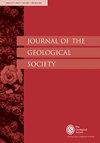伊朗南部晚白垩世新特提斯期蛇绿岩挤出层序的化学地层学及其对弧前构造背景下俯冲起始岩浆活动和熔体演化模式、速度的意义
IF 3
3区 地球科学
Q2 GEOSCIENCES, MULTIDISCIPLINARY
引用次数: 0
摘要
现代和古代弧前环境中挤出层序的熔岩化学地层学研究,提供了从俯冲起始岩浆作用(SIM)到弧初岩浆作用以及弧成熟相关岩浆作用的熔融演化过程中海洋地壳形成的重要信息。本文报道了伊朗南部外扎格罗斯带晚白垩世蛇绿岩的新微量元素和放射性成因Sr-Nd-Pb同位素数据,并通过SIM法讨论了其在新特提斯前弧环境下的岩浆发育。早期火山作用在哈吉-阿巴德蛇绿岩中形成了地层最古老的bonnitic (BON)熔岩,其微量元素比值和Pb同位素特征表明其为一个受俯冲板源流体污染的难熔地幔源。BON熔岩在结构上向上转变为岛弧拉玄岩(IAT)熔岩及其分馏的长英质衍生物,显示了沉积物衍生熔体在其岩浆源中的贡献的同位素证据。哈吉-阿巴德蛇绿岩的熔体演化模式与伊豆-波宁-马里亚纳(IBM)弧前熔岩序列的递进式熔体演化趋势有很大的不同,伊豆-波宁-马里亚纳(IBM)弧前熔岩序列从底部开始,弧前玄武岩(FAB)向上分段,形成BON和IAT亲和熔岩。IBM中的IAT熔岩依次被钙碱性(CAL)熔岩覆盖。我们的地球化学模型指出,可能存在一种消耗较少的俯冲前地幔,其部分熔融可能在波长岩熔岩喷发之前产生了原始岩浆,尽管在哈吉-阿巴德蛇绿岩中没有这种岩浆的记录。我们将外扎格罗斯蛇绿岩的化学地层学与该地区其他新特提斯蛇绿岩的俯冲起生火山岩的文献记录和IBM弧前环境进行了比较,强烈表明,SIM没有单一的规则或模板。补充资料:详细的分析方法和补充的数字和表格可在https://doi.org/10.6084/m9.figshare.c.6837597上找到。专题收集:本文是蛇绿岩、杂岩和蓝片岩收集的一部分,可在https://www.lyellcollection.org/topic/collections/ophiolites-melanges-and-blueschists上找到本文章由计算机程序翻译,如有差异,请以英文原文为准。
Chemostratigraphy of the extrusive sequence of a Late Cretaceous Neotethyan ophiolite in Southern Iran and its significance for the mode and tempo of subduction initiation magmatism and melt evolution in forearc tectonic settings
Chemostratigraphy of lavas in extrusive sequences of modern and ancient forearc environments provides significant information on oceanic crust formation through progressive stages of melt evolution from subduction initiation magmatism (SIM) to arc infancy, and arc maturation-related magmatism. We present here new trace element and radiogenic Sr–Nd–Pb isotopic data from a Late Cretaceous ophiolite in the Outer Zagros Belt of southern Iran and discuss its magmatic development through SIM in a Neotethyan forearc setting. Initial volcanism produced the stratigraphically oldest boninitic (BON) lavas in the Haji-Abad ophiolite whose trace element ratios as well as Pb isotopic signatures indicate a refractory mantle source, which was contaminated by subducting slab-derived fluids. The BON lavas change structurally upwards into island-arc tholeiitic (IAT) lavas and their fractionated felsic derivatives that display isotopic evidence for the contribution of sediment-derived melts in their magmatic source(s). This melt evolution pattern of the Haji-Abad ophiolite marks a major difference from the progressive melt evolution trends reported from the Izu–Bonin–Mariana (IBM) forearc lava sequence, which starts at the bottom with forearc basalts (FAB) phasing up-section into BON and IAT affinity lavas. IAT lavas in the IBM are in turn overlain by calc-alkaline (CAL) lavas. Our geochemical modelling points to a probable existence of a less depleted, pre-subduction mantle whose partial melting probably generated primary magmas before the eruption of boninitic lavas, although the record of such magmas is missing in the Haji-Abad ophiolite. Our comparison of the chemostratigraphy of the Outer Zagros ophiolites with the documented record of subduction initiation generated volcanic rocks in the other Neotethyan ophiolites in the region and the IBM forearc setting strongly suggests that there is no single rule or template for SIM. Supplementary material: Details of analytical procedures and supplementary figures and tables are available at https://doi.org/10.6084/m9.figshare.c.6837597 Thematic collection: This article is part of the Ophiolites, melanges and blueschists collection available at: https://www.lyellcollection.org/topic/collections/ophiolites-melanges-and-blueschists
求助全文
通过发布文献求助,成功后即可免费获取论文全文。
去求助
来源期刊

Journal of the Geological Society
地学-地球科学综合
CiteScore
6.00
自引率
3.70%
发文量
68
审稿时长
6-12 weeks
期刊介绍:
Journal of the Geological Society (JGS) is owned and published by the Geological Society of London.
JGS publishes topical, high-quality recent research across the full range of Earth Sciences. Papers are interdisciplinary in nature and emphasize the development of an understanding of fundamental geological processes. Broad interest articles that refer to regional studies, but which extend beyond their geographical context are also welcomed.
Each year JGS presents the ‘JGS Early Career Award'' for papers published in the journal, which rewards the writing of well-written, exciting papers from early career geologists.
The journal publishes research and invited review articles, discussion papers and thematic sets.
 求助内容:
求助内容: 应助结果提醒方式:
应助结果提醒方式:


